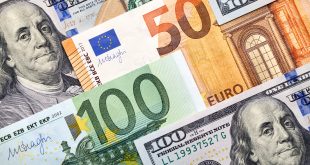Markets are anticipating the release of the United States Federal Reserve’s minutes of its April meeting, due to be released on Wednesday.
The meeting minutes are expect to publicly show some signs that there was a discussion among the monetary policy maker on whether the central bank should raise interest rates sooner than initially estimated.
Although the Fed has previously vowed to maintain the historically record low rates near 0% for about two or three years, the decision remains mostly linked to achieving the unemployment and inflation rate targets.
This is what the Fed has been pointing to as seeing “substantial further growth” in reaching full employment, by restoring the pre-pandemic unemployment levels, and the price stability target with the inflation rate sustainably reaching 2%.
However, the most recent reading of the consumer price index (CPI) has signaled a surge in inflation, which led to expectations that the Fed might be moving rates sooner than later, as previously expected.
But recent remarks by the Fed officials have repeatedly indicated the expectation that the surge in consumer inflation is likely to be temporary, with the Fed willing to tolerate inflation running above 2% for some time to reach the desired average.
It remains to be seen whether this point of view, expressed mainly by the Fed Chair Jerome Powell, is subject to the consensus of the the Federal Open Market Committee (FOMC) members.
Following a two-day meeting on April 27-28, the Fed decided to maintain its current monetary policy, with massive quantitative easing measurements to help the economy on the way to recovery from the coronavirus pandemic
The FOMC acknowledged the improving economic indicators with a recovery that remains uneven and far from complete.
The Fed statement then noted that “indicators of economic activity and employment have strengthened.”
The Fed still believes that the state of the economy remains linked to progress in the fight against the pandemic, with a decline in new cases and wider vaccination expected to help improve the recovery.
In a statement following the meeting, the Fed Chair Jerome Powell said that “it will take some time before we see substantial further progress.”
Powell said that “some of the asset prices are high. You are seeing things in the capital markets that are a bit frothy. That is a fact. I won’t say it has nothing to do with monetary policy, but it also tremendous amount to do with vaccination and reopening of the economy,”
“That’s really what has been moving markets a lot in the past few months, this turn away from what was a pretty dark winter to now a much faster vaccination process and a faster reopening, so that’s part of what is going on.”
Former U.S. Secretary of the Treasury, Larry Summers, said on Tuesday that the Fed needs to undetstand the market developments to adjust its policy.
“It is not tenable to assert today that in the contemporary American economy labor market slack is a dominant problem. Walk outside. Labor shortage is the pervasive phenomenon. Everywhere I look there are vacancies, people eager to fill the vacancies.”
Summers believe the expectations for maintaining the low interest rates until the end of 2023 led to dangerous complacency in markets in a way that poses the threat of real damage
“I think the prospects for avoiding turbulence over the next several years, both in the real economy and financial markets, would be substantially greater if there was a sense that monetary policy authorities in the United States were focused on the need to avoid overheating rather than focused on the need to reassure people that they won’t focus on overheating.”
“I would rather see us go back to a Fed that is concerned about preempting inflation, rather than a Fed that is concerned about preempting fears that it will be concerned about inflation.”
Meanwhile, the President of the Federal Reserve Bank of Atlanta, Raphael Bostic, said that he approves of the current policy despite the rise in inflation, as the jobs market maintains below its pre-pandmic levels.
Bostic told CNBC that until substantial progress is made to close the gap in employment, he thinks tge policies must be in a very strongly accommodative situation.
“I actually think that having a healthy level of inflation is a sign that the economy is healthy, the economy is going to be dynamic and growing and that should translate into jobs for the people who everyone is concerned about at the lower end of the wage distribution.”
Similarly, the Fed Vice Chair Richard Clarida said that economic growth could exceed 6% and reach 7% in 2021, expressing his view that the rise in inflation is likely to be temporary.
“What I would say is, in my judgment, through that April employment report, we have not made substantial further progress.”
“As the data come in, we will have to evaluate that and ultimately make a judgment on that.”
“It looks like the economy if anything can pick up speed this year…We could have growth north of 6%, possibly 7%.
“It may take more time to reopen a $20 trillion economy than it did to shut it down.”
He attributed his expectations to the fact that the pandemic was an unprecedented shock that led to an unprecedented collapse, but pointed to the possibility if an unprecedented recovery. “I think the thing I’m most confident about is we have to be attuned and attentive in looking at the data flow,”
Clarida further noted that the Fed will “give advanced warning before we anticipate scaling back the pace of those purchases.”
It is worth noting that recent remarks by the Fed officials suggested that before the central bank considers changing interest rates, it will likely begin by scaling back its massive asset purchases or the bond-buying program, a move that Powell will warn the market about ahead of the decision to avoid any shocks to the debt market.
 Noor Trends News, Technical Analysis, Educational Tools and Recommendations
Noor Trends News, Technical Analysis, Educational Tools and Recommendations





